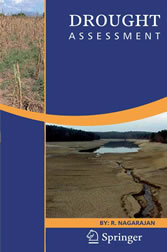Suchen und Finden
Title Page
2
Copyright Page
3
Preface
4
Table of Contents
7
1 Introduction
10
1.1 Climate Classification
11
1.2 Drought, Famine and Desertification
12
Classification of Drought
18
1.3 Factors Responsible
22
Precipitation
23
Temperature
24
Wind Velocity and Evapo-transpiration
24
Atmospheric Circulation
25
Hemispheric Nature
26
1.4 Effects of Drought
26
Social
27
Environment
28
Agriculture
28
1.5 Drought Forecasting
29
Traditional Knowledge
30
References
34
2 Meteorology
37
2.1 Weather
37
2.2 Tropical Activity
41
Monsoon
42
2.3 Precipitation Type
45
2.4 Weather Forecast
46
Methods
47
Forecast Types
48
2.5 Clouds
50
Cloud Identification
51
Cloud Observation
53
2.6 Cloud Mapping - Satellite
54
Rainfall Estimation
65
Application
71
2.7 Precipitation
72
Spot Measurement and Observation
73
Areal Representation and Network Design
75
2.8 Precipitation Climatology
77
2.9 Rainfall Reliability Wizard
80
References
83
3 Water Resources
86
3.1 Water Scarcity
86
Drying Rivers and Lakes
87
Falling Water Table
87
Climate Variation
89
3.2 Critical Issues in Water Resources
90
Human Activities
91
3.3 Hydrological Process
91
Rainfall-runoff
92
3.4 Water Requiriment
94
3.5 Water Balance under Natural Conditions
95
3.6 Irrigation Water
96
3.7 Ground Water
97
Aquifer
98
Classification
101
Vulnerability
102
Groundwater Exploitation Status Indicators
103
3.8 Water Recharge
108
3.9 Sustainability of Water
109
3.10 Groundwater Supply Systems
110
3.11 Crop Yield and Groundwater Abstrawater Abstraction
111
3.12 Stream Flow Analysis
112
3.13 Water Balance Method
116
3.14 Watershed Analysis
117
3.15 Surface Storage
119
Reservoir
119
3.16 Lakes Cascade Systems
119
Status of Tank Cascade
121
Tank Cascade Assessment
125
References
127
4 Agriculture
130
4.1 Soil
130
Agro-ecological Zone
137
4.2 Soil Water Irrigation
138
4.3 Crop Growth
143
4.4 Crop-water
148
4.5 Crop Irrigation
149
4.6 Water Use Efficiency
152
4.7 Water Stress Situation of Crops
153
Water Quality and Irrigation
156
4.8 Irrigation Management Practice
157
4.9 Soil Water Analysis
161
4.10 Plant Growth Simulation and Drought Event Analysis
162
4.11 Drought Forecasting/Prediction of Events
163
Ranking and Weightages
165
References
166
5 Drought indices
169
5.1 Drought Assessment Parameters
171
5.2 Indices
176
5.3 Meteorological Indicators
177
5.4 Hydrological Indicators
189
5.5 Agricultural Indicators
193
5.6 Sociological Indicators
199
5.7 Environmental indicators
207
5.8 Indicators and Triggers
208
References
212
6 Satellite Remote Sensing
214
6.1 Remote Sensing
214
6.2 Orbital Satellites
217
6.3 Satellte Orbit
220
6.4 Commercial satellite
223
6.5 Sensors and Products
227
6.6 Spectral Data Analysis
233
6.7 Visual Interpretation
233
6.8 Digital Image Processing
236
Pre-processing
236
6.9 Image Enhancement
239
Contrast Enhancement
242
Spatial and Directional Filters
243
Multi-image Manipulation - Arithmetic Operation
246
Principal Components and Canonical Analysis
247
Intensity-Hue-Saturation (IHS) Colour Space Transformation
249
6.10 Image Classification
249
Unsupervised Classification
251
Supervised Classification
254
6.11 Post Classification Processes
256
Classification Accuracy
256
6.12 Multi-sensor Data Merging
257
Change Detection Procedures
257
Data Fusion
257
6.13 Indices for Drought Analysis
260
Vegetation Indices
260
Thermal Brightness
265
Albedo Index
265
Evapotranspiration Estimation
266
6.14 Temporal Analysis
268
References
272
7 Spatial Data and Geographical Information System
274
7.1 Geographic Information System
274
7.2 Spatial Data
278
Spatial Data Type
278
7.3 Thematic Map
279
Map Charateristics
280
Map Projections
280
Location Information
282
7.4 Data Conversion
283
Presentation of Information
285
7.5 Data Models
285
Vector and Raster Model
285
Spaghetti Model
287
Geo-relational Model
287
7.6 Attributes of Data
288
Triangulated Irregular Networks (TIN)
289
7.7 Spatial Data Transformation
290
Conversion of Points
291
Interpolation Method
293
Triangulation Method
293
Inverse Distance Weighing
293
Dialation of Spatial Objects
293
7.8 Data Analysis
294
Database Query
294
Buffer Operation
294
Digital Terrain model
295
DEM Generation
297
Interpolation Methods
298
Network Analysis
299
Overlay
299
7.9 Modelling
302
Weighing and Rating
302
Interpolation
303
Map Modelling with Attribute Tables
304
7.10 Web-based GIS
306
7.11 Creation of Spatial Data Base in Kolar, India
310
7.12 Decision Support System
321
7.13 Alert System
322
Drought Alert Information System (DAIS)
324
References
328
8 Vulnerability Assessment
329
8.1 Drought Assessment
329
Australia
336
New Zealand
339
United States of America
339
China
343
South Africa
343
Portugal
343
8.2 Vulnerability
344
8.3 Vulnerability Analysis
349
Ranking and Weightage
350
8.4 Vulnerability of Water Supply System
357
8.5 Risk
358
8.6 Drought Scenario
362
8.7 Decision-making
364
8.8 Contingency Drought Plans
367
Crop Insurance
369
References
371
9 Resources, Drought Events and Management Proffile of Countries
373
9.1 Africa
373
9.2 Tropical Countries
379
Afghanistan
379
Autralia
381
Bangladesh
389
Iran
392
Jordan
393
Pakistan
396
9.3 Non-tropical Countries
399
Canada
399
China
402
European Union
411
United States of America
417
Russia and USSR
426
9.4 Water Politics
427
9.5 Drought Strategies
428
References
430
Index
433
Alle Preise verstehen sich inklusive der gesetzlichen MwSt.








